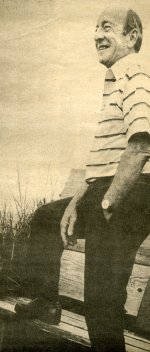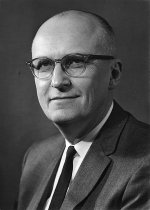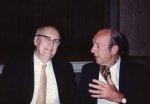
Fred Harvey Harrington: Committed, Tough and Foxy Educator and Liberal.
A manuscript written circa 1985. Harrington (1912-1995) served as professor of history at the University of Wisconsin for more than three decades, and for nine years was the university's president.

William Appleman Williams.
Image courtesy of the Oregon State University Daily Barometer, July 10, 1986.
[Author's Note: The basic source for this essay is my association and friendship with Harrington, and his students. He proved most accommodating and candid in response to my rather pushy questions. Additional helpful information came from others named in the text, and from "civilians" in Madison. If quotations have no attribution, they are from Harrington. Others are identified in the text. I am grateful to all who helped me.]
The building is still there.
No, not Bascom Hall. No, not the gracious home on Power Hill. We will climb to those in good time.
Our first stop is a huge three-story house along Langdon Street where it bends a bit along Lake Mendota. A rare vista for poor and struggling graduate students in 1947.
Well, not dirt poor. There was the GI Bill. And working wives. Even working husbands. And the hope of a teaching fellowship.
The ritual. Sleep in on Sunday, and then play. Gear up on Monday; and beginning on Tuesday work yourself to the bone Wednesday through Saturday night in seminars, libraries, and book stores to earn the A's and the money to buy books and go to the movies - and get a bit of booze. After all, you are doing American history in the best department in the United States (and arguably the best in the world).
Perhaps then the best University.
There is no easy way to write an institutional history of an entire university. There may be no way. That is because a true university is a community of faculty and students and taxpayers learning together to confront reality at less than 10 centimeters and make some sense of it in order to act more intelligently and consequently in the larger world.
As we work our way toward an understanding of Fred Harrington's central role in doing that at Wisconsin after 1940, let us return to that old building on the curve of Langdon Street.
There are four people walking on Langdon southwest from Capitol Square about 10 p.m. One of the men is unusually tall. He is holding hands with a vivacious, shapely woman at least a foot shorter who moves with remarkable rhythm and grace. She has been a professional dancer. Behind them come a couple of more normal size. They are also holding hands. The group arrives at the door of the building and does a bit of a shuffle to allow the smaller couple to lead the other couple up to the third floor. The tall man's lady wishes to relieve herself and so is taken down a long hall lighted by two weak bulbs to the convenience. Fortunately it is too early for the resident bats to be out in force.
They reconvene and taste their drinks and begin to talk seriously about the movie they have just viewed together. Shortly, the tall man lifts his empty glass. After his and others are refilled he changes the subject.
His name is Fred Harvey Harrington, and his wife is Nancy. They have lived together many years and have four children. Three girls and one boy.
We can now begin to comprehend the magic that they deployed to sustain and extend the quality of a university by inspiring and leading the History Department and later the University.
Magic is magic.
The story is rather like one of those Faulkner sentences with brackets within parentheses. If you try to parse such a sentence, you are driven to the conclusion that it makes no sense. But if you read it with an open soul, you are graced with a glimpse of the truth.
In this case several truths. The man is contradictory and loving, and frustrated and angry. He cares deeply about the character of a university. One has the thought that a movie camera would be the best way to capture him. He was always in action. If you could do that, then you would go into the cutting room and pace back and forth. You would throw up your hands. For despite the patchwork impression, he is integrated - whole, of a piece.
Let us do our best to put the man in perspective. Perhaps the best strategy is to focus on the events across the turn of the century when Robert M. LaFollette and academic leaders like President Van Hise joined with academics down that long vista between the Capitol and Bascom Hall.
Under the intellectual leadership and political savvy of President Van Hise, a fascinating faculty was coming together. In political economy there were men like Commons, Ely, and Paul Reinsch. History was led by Frederick Jackson Turner. He hired exceptional men of his generation: Alfred L. P. Dennis and others. But Turner went to Harvard in 1910, and his successor, Frederick Paxton, rapidly "lost" the new outsiders, and in their place began to hire only Wisconsin graduates. Such a disastrous policy did away with Monro, Sellery, and others.
When Paxton moved on to California at Berkley, he was succeeded by John Hicks who shortly gave way to Paul Knaplund.
Knaplund was a student of A. L. P. Dennis, but he quickly reversed Paxton's incestuous policy. He did not hire a Wisconsin Ph. D. for 12 years.
Instead, he hired William Best Hesseltine, Gaines Post, Fred Harvey Harrington, Charles Edson, Merle Curti, Merrill Jensen, and Paul Farmer. Knaplund "ran the department" (and finessed the Dean) from 1932 to the mid-40s.
During those years Harrington played no major role in departmental politics. Indeed, there is a revealing tale, also hilarious, about Harrington's "role" during those years. It is said that Knaplund and Hesseltine masterminded this scenario. A good job opened at Arkansas, so the plot took this line: The department would submit the names of Harrington and Hesseltine's student T. Harry Williams. The plan was to use Harrington to get him a raise at Wisconsin and get Williams the job at Arkansas. (This offers a preview of the placement system as later fine-tuned by Harrington as "The Big Red Machine.") Harrington however, got the job because the people upstairs offered him no raise, and Williams stayed put for a spell.
But Harrington did well in the long run. He is the only person who ever left the department and was later asked to return.
He began to "run the show" after he returned in 1944. He had his opportunity to build a great university, and he, as perhaps Nancy would say, Seized the Day. In an idiom perhaps closer to his style, he took the world he found by the throat and undertook to make it better.
Let us emphasize at the outset and review the intellectual side of that achievement. He was an active productive scholar, a truth too often forgotten. He published more than a few seminal articles (i.e. on anti-imperialism) and books that remain worth serious attention. His study of Horace Allen in Korea remains pertinent in understanding post-1945 events. His change of pace in The Hanging Judge reveals not only his range and how he used his experience in Arkansas, but also his respect for local history and command of style. He often remarked in commenting on PhD theses that the compound-complex sentence with some declarative sentences was the best idiom for writing history, and in general that was on the mark. But in the textbook for which he wrote the final draft, he experimented with Ernest Hemingway's style in a fascinating way - and revealed the weakness, self-defeating limits, of that style for History. It also displayed the intellectual spirit of Harrington.
That intellectual quality is a key to his ability to energize and focus the energy of the entire Wisconsin faculty. He challenged people across the campus.
One story will suffice. I happen to have known Karl Paul Link quite well. Many times he said to me:
"Your boss has done more for this university than anyone in my experience. I sometimes disagree with him, but he is honest and actually enjoys a good tough discussion."
Link won the Lasker Prize. His work first found the cause of scours in young cattle. His genius then turned that around to kill rats and extend the lives of people who had heart trouble (i.e. Dwight Eisenhower) and blood clotting in all its forms. He named the basic drug Wisconsin Alumni Research Foundation, Inc., and assigned a large portion of his patent royalties of that trademark to that foundation with the explicit condition that it be used for the "Liberal Arts as well as Science."
That is respect from a Heavy Hitter.
People also respected him for remaining through all his public service as an engaged parent. Many of his students were in their home for discussing thesis chapters and later as faculty. That is a difficult task, particularly with medical tragedy affecting his son. When the son died, Harrington gave the funeral oration. A committed man.
All such activities go far to explain his quiet effectiveness with students. He was clearly the Father of the "Wisconsin School of American Diplomatic History." He was tough, candid, and always willing to give of his time. He had unnerving knack of answering a question and then going back to the precise word he was using when you interrupted him.
Students came to cherish him. They masked that emotion with nicknames like "The Fish Eye" and "Mr. Cool."
Therein lies a fascinating story. At the insistence of bald Hesseltine (known of course as "Curley"), the graduate students created a "faculty" of their own. Hesseltine came by periodically as a good parent should. Harrington never needed to do so because the students brought him into every discussion. Warren Susman, in one of his great moments of insight called it "The Smoking Room School of History," and immortalized it in his collection of essays.
His students are impressive. Also the people he hired when the Executive Committee decided to bring back some of its best students. That was difficult because the department was a pressure cooker, and most of those people left. One of the best examples was Christopher Lasch who said bluntly: "This place is more than I can handle."
He was a great leader, but his basic mode of operation was democratic.
He sustained the policy when he became University President.
That part of the Harrington Saga is not strictly part of this account, but some examples are illuminating. He established the principle of monthly open faculty meetings with an agenda conducted by Robert's Rules of Order and full debate. He did not like to lose, but accepted it in full faith. He presided over the physical expansion across University Avenue, when many faculty thought it was premature. It became something of a disaster. The practice of open meetings was later killed by the Regents and other elites. He steered the University through the troubles of the 1960s. He survived and saved the University. He had serious encounters with what was accurately defined as the anti-intellectual group among the protesters who did want to destroy the nature of the University. Harrington was determined to present that. But again he lost to the Regents and other politicians.
A remarkable man, who with Nancy, did take existing reality by the throat and make it better. Along with many others, I cherish the man.
Table of Contents
- The Politics of Ecological Balance
- Seven Americas on the Way to the Future: An Exploration of American History
- The Crisis of American Democracy
- The Legacy of Karl Marx: Or, the Inheritance We Dare Not Squander
- The Intellectual in American Public Life
- Commencement Address
- Fred Harvey Harrington: Committed, Tough and Foxy Educator and Liberal.
- The Intellectual Menopause and Changing One's Major
- The Comparative Uses of Power: China on the African Rim and the United States on the Pacific Rim
- Harvey Goldberg and The Virtue of History
- Vietnam and the Revival of An Anti-Imperial Mood and Movement In the United States and the Beginnings of a Thaw in The Cold War.
- America As a Weary and Nostalgic Culture
- The Potential of Higher Education



